Motorola Spirit GT User Manual
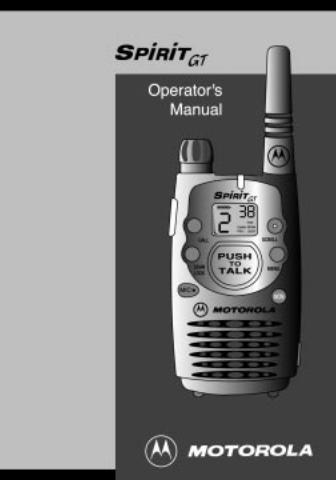

FCC Licensing Information
Your Motorola radio operates on FM radio communication frequencies and is subject to the Rules and Regulations of the Federal Communications Commission (FCC). The FCC requires that all operators using Private Land Mobile frequencies obtain a radio license before operating their equipment. Application for your FCC license is made on FCC Form 600 and schedules D, E, and G. To have the forms faxed to you by the FCC, call the FCC
Fax-On-Demand system at:
1-202-418-0177
from your Fax machine and request document 000600 for all forms and instructions.
To have the forms mailed to you, call the FCC forms hotline at:
1-800-418-FORM
(1-800-418-3676)
For questions concerning the license application, contact the FCC at:
1-888-CALL-FCC
(1-888-225-5322) Or:
http://www.fcc.gov
Before filling out your application, you must decide which frequency(ies) you can operate on. See frequency table on page 27. For questions on determining your radio frequency, please call Motorola Product Services at:
1-800-448-6686

Table Of Contents
Your New Radio |
|
Spirit GT Series Features |
|
|
Radio Diagram |
2-3 |
Display Light |
|
14 |
|
|
Auto Reset |
|
14 |
NiMH Battery |
|
Time-out Timer |
|
14 |
Removing Battery Door |
4 |
Lock |
|
15 |
Installing the NiMH Battery |
5 |
Spirit GT+ Features |
|
|
Charging the NiMH Battery |
6 |
|
|
|
Battery Meter |
7 |
Channel Scan-Spirit GT+ Only |
16 |
|
Low Battery Alert |
7 |
Activating Scan Feature |
|
16 |
|
|
Pausing on a Channel |
|
16 |
Belt Holster |
|
Hands Free Use |
|
|
Using Radio with Holster |
8 |
|
17 |
|
|
|
Enabling VOX |
|
|
Before You Can Talk |
|
Setting VOX Sensitivity |
|
18 |
Spirit GT Radio Frequencies |
9 |
Additional Information |
|
|
Interference Eliminator Codes |
9 |
|
|
|
Bands |
9 |
Accessories |
|
19 |
|
|
Talk Range |
|
20 |
Operation |
10 |
Care and Safety |
|
20 |
Turning the Radio On |
Troubleshooting |
|
|
|
Adjusting the Volume |
10 |
|
|
|
Monitoring Channel Activity |
10 |
Troubleshooting |
21-22 |
|
Call and Alert Tones |
11 |
Safety Information |
|
|
Transmitting Messages |
11 |
23-24 |
||
|
|
Cautions and Warnings |
||
Programming |
|
Charging Safety Instructions |
25-26 |
|
Changing the Channel - |
|
Frequency Chart |
|
27 |
Spirit GT+ Only |
12 |
|
||
Programming a Frequency |
|
Interference Eliminator Code |
|
|
to a Selected Channel |
12 |
Chart |
|
27 |
Exiting Programming Mode |
12 |
Warranty |
|
|
Programming the Code |
13 |
|
|
|
Frequency and Code Verification 13 |
One Year Limited Warranty |
28-29 |
||
|
|
Computer Software Copyrights |
30 |
|
|
|
Specifications |
|
31 |
1

Your New Radio
Congratulations on your purchase of the Spirit GT Business Radio. Your radio is a product of Motorola’s 70 plus years of experience as a world leader in the designing and manufacturing of communications equipment. With proper care and use, your Motorola radio should give you years of reliable communication.
Motorola Spirit GT professional two-way radios are the perfect communications solution for all of today’s fast-paced industries. Designed to help meet the demands of the modern workplace, these radios are compact and durable. A powerful communications tool, these “line-of-site” radios can communicate up to 4 miles in clear, unobstructed environments.
Contents of Package
Radio
Holster
NiMH Battery
3 Hour Charger Adapter
Literature (Not shown)
Owner’s Manual
Warranty Card
Quick Reference Guide
On-Off/Volume Knob
Used to adjust volume, turn radio on or off.
LED Indicator Light
Indicates radio is on; will be steady red when transmitting.
Battery Meter Indicator
Indicates how much battery charge is left.
Accessory Connector
Used for plugging in optional audio accessories.
Call Button
*1 Channel Model
**2 Channel Model
Calls other radio users.
Lock Button* Scan/Lock Button**
Scans frequencies for activity.
Locks radio to prevent accidental change of settings.
Internal Microphone 
Used to talk into.
2
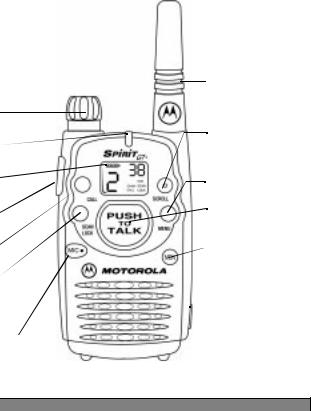
|
|
GT+ Model Shown |
Please read this manual |
|
carefully to ensure you |
|
know how to properly |
|
operate the radio before |
|
use. |
|
FCC License required. |
Antenna
(Not removable)
Scroll Button
Changes radio settings. Used for frequency and code verification.
Menu Button
Changes function mode.
Push-To-Talk Button
Used to transmit messages.
Monitor Button
Monitors frequency activity. Used with On-Off/ Volume Knob to adjust volume.
 Charging Connector
Charging Connector
Used for charging battery.
Figure 1.
3
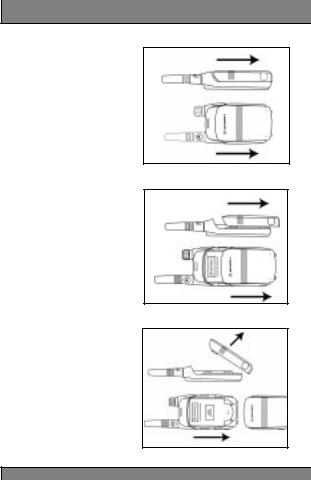
NiMH Battery
Your Spirit GT radio operates on a Nickel Metal Hydr ide (NiMH) rechargeable battery. The NiMH rechargeable battery will provide up to 9 hours of operation with normal use. Standard 5/5/90 duty cycle (5% transmit, 5% receive, 90% standby).
Removing the Battery Door:
1.Grasp radio with one hand, display side down (do not hold radio antenna).
2.Slide battery door back half-way until you feel resistance.
Figure 3.
3.Remove battery door from radio by lifting door up as shown. Figure 4.
Step 1
Figure 2.
Step 2
Figure 3.
Step 3
4
Figure 4.
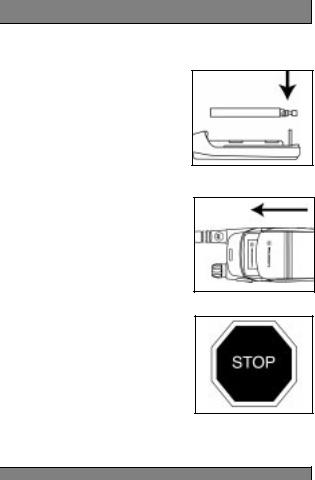
Installing the NiMH Battery:
1.Remove battery door. Figures 2-4.
2.Insert NiMH battery so that the contact sides are down (see note below). Figure 5.
3.Replace the NiMH battery door by positioning it halfway up the radio body. Figure 6.
4.Push battery door up until secure.
Stop Sign: The NiMH battery has a stop sign symbol to remind you to turn the battery over and align holes with pegs before inserting battery into the radio, contact sides down. Figure 7.
When power is low, recharge the battery immediately to avoid interrupted use.
Figure 5.
Figure 6.
Figure 7.
5

Charging the NiMH Battery:
To get maximum use from the battery, charge it for at least five hours before you use it for the first time. After initial charging, battery will fully charge in about three hours.
1.Turn the radio off.
2.Plug charger into an AC wall outlet. Figure 8.
3.Lift the charging connector cover on radio (not detach-
able) and plug charger con- |
|
|
|
Figure 8. |
|||
nector into jack. Figure 9. |
|||
4. LED Indicator on Battery |
|
|
|
Charger will flash. (See |
|
|
|
chart below for complete |
|
|
|
charging status). |
|
|
|
Notes: For optimum battery life, battery should not be left charging for extended periods.
Do not transmit while radio is charging. Transmitting while radio is charging can cause transmitter or charger to operate improperly.
Turn radio off when charging. If radio is on while charging, at least twice as much time is required to charge the battery.
The battery may also be charged outside of the radio.
LED Color |
Charging Status |
Completion |
Solid red |
Rapid |
Up to 90% |
Flashing Green |
Top-off |
90% to 100% |
Solid Green |
Complete |
100% |
Flashing Red |
Battery Fault |
______ |
Flashing Yellow* |
Standby |
______ |
*Battery is not receiving correct voltage. Battery charging temperature must remain between 00 to 400 C/320 F to 1040 F.
6
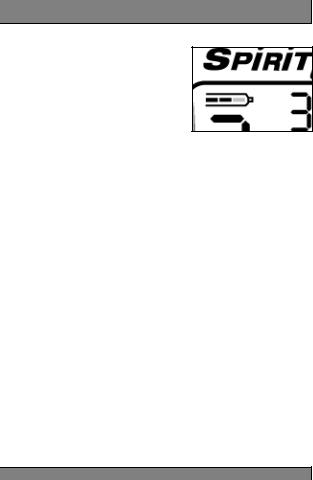
Battery Meter
The battery meter, located on the display, is divided into three bars. As power is used, the bars will disappear. Figure 10.
Note: To ensure proper functioning of the battery meter use only the Motorola NiMH rechargeable battery included with your
radio. Figure 10.
Low Battery Alert
When the battery is low, the radio will beep:
•3 to 4 seconds after turning power on
•every 10 minutes in standby mode
•after releasing Push-To-Talk button
•after releasing the Call button
Note: Remove battery before storing your radio for extended periods. Battery may corrode over time and cause permanent damage to your radio.
7
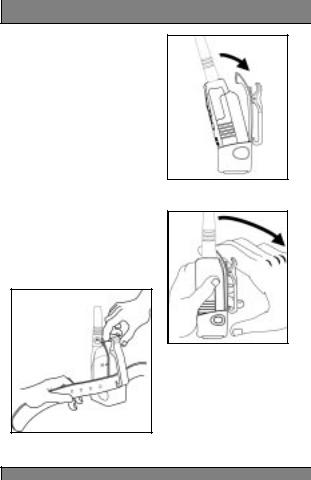
Belt Holster
Spirit GT radios come with a belt holster.
Using Radio with Holster:
1.Position the base of the radio in bottom of holster.
2.Push the radio towards the holster until it latches into place. Figure 11.
3.To remove radio from holster, pull the top tab on holster away from radio. Figure 12.
4.Attach radio in its holster to your belt or waistband. Figure 13.
Figure 13.
Figure 11.
Figure 12.
8

Before You Can Talk
Read this manual carefully, make sure you know how to properly operate the radio before use. Spirit GT radios have 1 channel and Spirit GT+ radios have 2 channels, both have 38 Interference Eliminator Codes. To talk to others, all radios in your group must be set to the same frequency and code.
Spirit GT Radio Frequencies
You can only communicate with any radios that are set on the same frequency and code. The chart on page 27 shows you the 8 frequencies on which Spirit GT business two-way radios can operate.
You can program any one of the eight frequencies (F1 through F8) to channel 1 for the Spirit GT one channel radio or to channel 1 or 2 for the Spirit GT+ two channel radio.
Interference Eliminator Codes
Codes filter out static, noise and unwanted messages on radio channels. Since radio channels can be monitored, this will not make your conversations private. To avoid a congested frequency, change radio’s frequency/code setting. See chart on page 27 for code frequencies.
Bands
FCC Regulations require that most new licensees must be operating on 12.5 kHz channel spacing capable radio. The Spirit GT and Spirit GT+ radios operate on 12.5 kHz channel spacing and may not have optimal sound quality when used with radios operating on 25 kHz channel spacing. If you have any questions, call Motorola Product Services at 1-800-448-6686.
9
